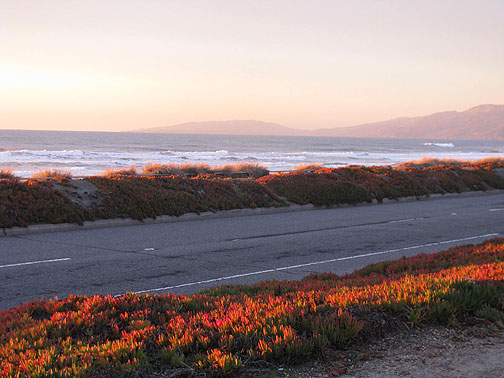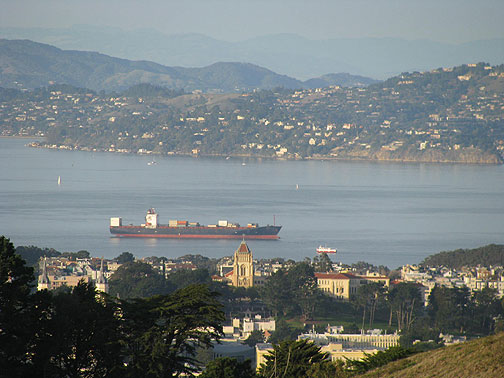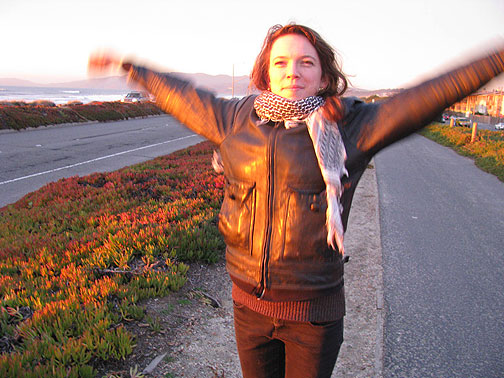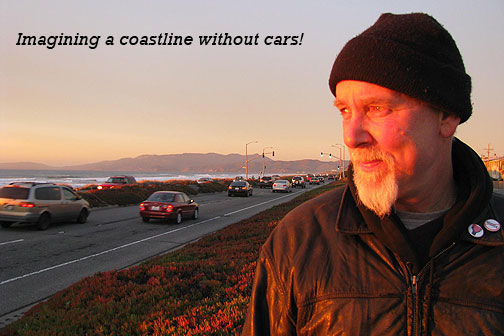Feeling the heaviness of Oscar Grant, murdered by a BART cop a couple of days ago. Over in Oakland, at the Fruitvale BART station, some kind of ruckus occurred, and in the video clips below, you can see it unfold. After the police had corralled several youth, one was squirming facedown and a cop tried to suppress his movement, after which he stands up, unholsters his gun and shoots Grant in the back, killing him. Unbelievable. But real.
http://www.youtube.com/watch?v=aXAETrZghn0
http://www.youtube.com/watch?v=tgzNBpjCNX8
This kind of behavior, ostensibly to enforce “security,” is parallel (on a small scale) to the insane barbarism of Israel’s assault on the Palestinians of Gaza. Wildly disproportionate violence is inflicted to protect the “security” of mass society. Lots of people I know are sick about Israel’s criminality, and watching this video of a police murdering a kid in Oakland brought it all home to me.
I grew up in Oakland from 1967-1974 and I have seen a lot of this kind of “police action” over the years, though not often leading to cold-blooded murder. I’ve also had the shit beaten out of me by criminal thugs, so I’m not oblivious to the fear and loathing that can erupt suddenly and for no apparent reason on the streets, in the trains, wherever. When it does it’s easy to wish for a cop to save you. But the violence that sits just beneath the thin veneer of “civilization” is as extreme, and to understand the day-to-day anger and violence that erupts so unexpectedly one has to look at the deeper violence of this society: the matter-of-fact use of aerial bombardment as a tool of foreign policy, the intensely armed presence of police inflicting steady harassment and intimidation in neighborhoods “of color” every day, the absurd levels of incarceration, etc. ad nauseum.
I just finished reading “Framing the Black Panthers: The Spectacular Rise of a Black Power Icon” by Jane Rhodes. This is a masterful work, providing a great deal of detail on the events that make up the history of the Black Panthers, especially in Oakland and San Francisco during the 1967-1972 period. But even more crucial almost 40 years later is her fantastic “reading” of the media coverage at the time, and subsequent to events. The individuals in the Panthers worked hard to gain attention via newspapers and television, and succeeded beyond anyone’s imagination, burning into the cultural landscape a phalanx of black militants garbed in black berets, leather jackets, opaque sunglasses, and wielding rifles and shotguns in a theatricalized expression of Black Militancy. Not that their guns were mere props. They were used on many occasions, since the deeper story involves intense police harassment up to and including open assault with massive firepower. Rhodes is at her best in the conclusion where she draws out the critical historical thinking that does not try to glorify the Black Panthers, or excuse or deny their occasionally anti-social behavior, but seeks to place them in their own historic agency and context.
“To call the Black Panther Party a “media-made” movement is too easy; it assigns the power of representation to media institutions rather than their subjects. This assertion ignores the dialogic relationship–the interdependence–between media producers and media subjects and erases individual and group agency. Rather, we might see the great power of the Black Panthers in their ability to create, manipulate, and subvert mass culture… The Panthers weren’t invented by the media–Bobby Seale, Huey Newton, Eldridge Cleaver, David Hilliard, Kathleen Cleaver, Fred Hampton, and a handful of other actors invented themselves and delivered the goods to the mass media.
“The cultural matrix of the black power movement, which integrated fashion, soul music, street theater, underground journalism, African spirituality, and urban vernacular, disrupted basic assumptions about how politics is conducted. For many observers, then, the Black Panthers inhabited a hyperreal state in which it was unclear whether the meaning they embodied was superseded or replaced by the signs, symbols, and rhetoric that swirled around them. This lent credibility to the idea that there was nothing behind their image but Oz-like wizardry. The Panthers’ very materialist perspective argued otherwise–that it was their claims of race, class, and gender prejudice, not cultural context, that encouraged most elites to deny their importance.”
I’ve always felt a peculiar connection to the Black Panthers, perhaps because I grew up very near to their stomping grounds in North Oakland. I remember well being afraid to go to Bushrod Park (where the surviving Panthers held a 30th anniversary reunion in 1996), a place that I was sure I would be attacked. But I was attacked on my elementary schoolyard not far from there, albeit in a harmless way (spit in the face, stolen baseball mitt and bat, that sort of thing); I also spent countless hours shooting baskets with lots of guys, mostly black, at St. Augustine’s on Alcatraz while I was age 11-14, and in one memorable afternoon I was playing one-on-one with a guy who must’ve been 17 and had me laughing so hard I almost fell over. I was wearing some cutoff jeans that my mother had patched with some black patches on the worn-out rear, and this guy (who I was holding my own with for a while, even though he had 6-8 inches on me) started a whole legend about how I was the leader of the infamous Black Patches, and as he spun the story full of allusions to recent events involving the Panthers I fell apart and couldn’t keep playing, helpless with mirth.
I had a lot of curious and historically specific moments in my childhood… when I first arrived in my 5th grade classroom a guy who later became my best friend, Clifford Fortune, started taunting me in the back of the class: “Hey man, can you dig it?… Can you DIG it?” This was October 1967 and I had no idea what he was saying (we were 10 years old) but I felt very intimidated by him. My 5th grade was taught by a gimpy old Jewish man named Mr. Signor, who had so given up on us that he didn’t even try to teach any math all year! The soundtrack of that year was provided by James Brown “I’m Black and I’m Proud!” and the Temptations “Ball of Confusion”. I was one of two white kids in the class. When news came that Martin Luther King was assassinated, the teachers led us all into the auditorium where we little kids sat terrified as the middle schoolers came in a mob and began pounding on the doors. I think they broke a few windows but I only remember the terror as the doors were splintering and we didn’t know what kinds of monsters were outside trying to get in.
The next year, 6th grade, the Oakland Public Schools shipped me from Peralta where I was, to Chabot, where I was in a class of “gifted” students… only one black kid! The year after that, 7th grade, both schools fed into the same junior high, Claremont (next to Rockridge BART now) and over the ensuing 3 years I watched as the demographic of the school went from relatively balanced to heavily black as the white kids departed for private schools (1969-1972).
I didn’t really understand what was going on around me. But by the time I left Oakland in 1974 I had been severely mugged in a racial beating, but also felt a deep affinity with black culture. My life went towards “white world” from then on, though, and I’ve never been immersed in black culture again.
Another book I just finished that sends its own tracers through this period of history is Dorothy Bryant’s “The Berkeley Pit.” Firstly I want to say that Dorothy Bryant is one of my favorite historical writers. I loved her “Miss Giardino” and “Confessions of Madame Psyche”. But I didn’t love this one. It tells the story of a female creative writing professor and her relationship to a young Vietnam vet student who hails from Butte Montana, the site of the huge Berkeley Pit, full of toxic waste from copper mining. It’s a rumination on the life destroyed in the mining town, juxtaposed to the slow disintegration of the idealism that fires everyone up during the 1960s in Berkeley, in particular the events surrounding Peoples’ Park. Black Panther Eldridge Cleaver is a character in the book, first as a fiery speaker during the anti-war, pro-Park riots, and later as a sad sack who haunts the bookstore that the former student/vet returns to Berkeley to own. (Cleaver’s story is part of Jane Rhodes’ book too, following his odyssey from the East Bay in and out of jail, to exile in Cuba and Algeria, and eventually back to the U.S. as a born-again right-wing evangelist–in Bryant’s novel he becomes a shadow of his old self, dozing in the bookshop after all his fire and notoriety have burned up.)
The Cody’s of Cody’s Books are present, and the whole Telegraph Avenue scene is well captured, including its recent demise. There are poignant moments here, but overall there is an odd detachment, a somewhat pedantic tone too often. Ultimately Bryant bitterly includes a subplot of a Homeless Collective’s occupation of the house next door to the professor, a collective led by a rabblerouser from the ’60s and Peoples’ Park. The impossibility of evicting the dysfunctional and antisocial “neighbors” who are living in squalor and making noise and defecating in the backyard acts to discredit the whole liberal project that is embodied in the notion of “Berkeley.” But I know Bryant is still progressive, so it’s an interesting way of criticizing the decay of the left and the movements of the ’60s, to show how the once vibrant youth culture turned into an endless stream of lonely, isolated and defeated youth, who before long turn into lifelong derelicts living in subhuman conditions… or so it’s portrayed in the novel! Cleaver’s decay, documented well enough in various histories, serves as another example the lost promise of that hopeful era.
It seems that we’ve been doomed to spend a lot of time recycling and rethinking the ’60s. Perhaps the best we can hope for is an honest appraisal and a clearing of the air, to get ready for the next round of social upheaval… and none too soon! Between Greece and the incipient tremors beginning to appear in many places, all contextualized by the global collapse, we are about to enter a period of rapid change and a noticeably sped-up history.
I put some photos on my Facebook page and I’ll pop a few in here too, just as a postcard to those who enjoy my photos… Happy New Year!

Ice plant on Great Highway ablaze in golden sunset light.

Close-up from Twin Peaks northward, partially filled container ship entering bay, Tiburon in background.

Francesca readying for flight.













Leave a Reply